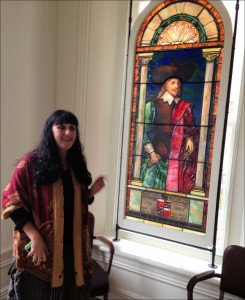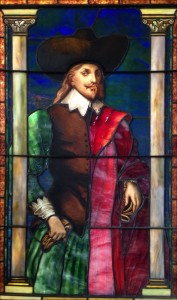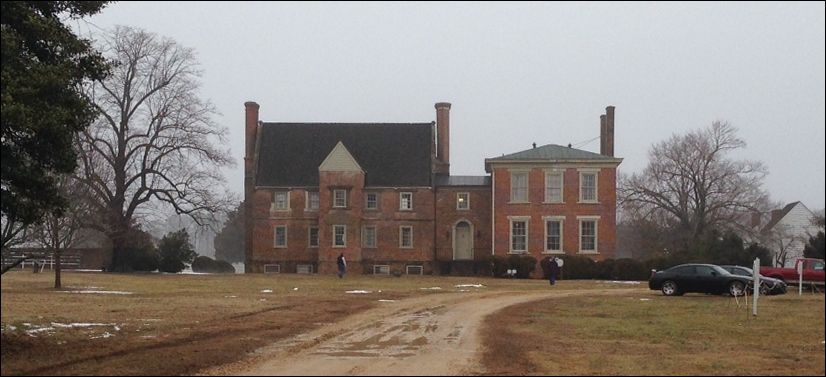by James A. Bacon
Bacon’s Castle, a 17th-century brick plantation house in Surry County, is vaguely known by Virginians for playing some kind of role in Bacon’s Rebellion, the first rebellion in the North American mainland against the English crown. Despite my passing interest in the conflict, I knew little about the building — other than the fact that the man it was named for, Nathaniel Bacon, never set foot in it.
But the story behind Bacon’s Castle is a fascinating one, I learned this morning during a tour of the building hosted by Preservation Virginia in connection with its 350th anniversary. All Virginians learn the story of Jamestown and its cast of characters from Pocahontas to John Rolfe. We revere Virginia’s founding fathers and the plantation aristocracy from which they sprang. We worship our Civil War heroes (well, some of us worship them). But there is a century-long gap between founding of Jamestown and the glories of Williamsburg about which we know almost nothing. Bacon’s Castle is a window into that forgotten era.
Built in 1665 Bacon’s Castle is one of the most architecturally significant buildings in Virginia. It is the oldest standing brick edifice in the English colonies. It also happens to be the only surviving example of Jacobean architecture on the North American mainland. (Barbados has two surviving structures.) The building was laid out in the form of a cross and it boasted spectacular triple-stacked Flemish gable chimneys. But the “castle” is more than bricks and mortar — it’s a place where history was made.
Preservation Virginia told that story as part of a fund-raising effort tied to the 350th anniversary of the building’s construction. Dedicated to preserving Virginia antiquities, the organization purchased Bacon’s Castle in 1974, made critical repairs and opened it to the public. Sad to say, it’s not one of Virginia’s hottest tourist attractions — it doesn’t exactly rank up there with Monticello, Mount Vernon or Williamsburg — and it’s showing signs of wear and tear. Over and above the flaking window paint and separating wood joints, the structure needs a new roof, repointed mortar and rehabilitation work on an 1820s-era smokehouse and a slave cabin. The total of repair bill amounts to $500,000, but Preservation Virginia hopes to raise $350,000 for the 350th anniversary.
Arthur Allen, a wealthy Englishman, arrived in Jamestown in the 1630s and obtained land across the James River in Surry County, where he cultivated tobacco. His enterprise prospered and by 1665 he completed construction of the building. By 1676 the Allen family’s land holdings had increased to 1,000 acres. Surviving documents listed eleven indentured servants and four African slaves in the household around that time.

Jennifer Hurst-Wender with Preservation Virginia desribes a romanticized stained-glass portrait, circa 1900, of Nathaniel Bacon.
Allen’s son, Arthur Allen II, was known as one of the wealthiest planters in the colony. The house is said to be the seventh largest in Virginia at that time, and it was possibly the first to have a formal English garden. (There are only archaeological traces of it now.) Allen cultivated the native Norton grape and was wealthy enough to import from Germany glass wine bottles embossed with his initials. He served in the House of Burgesses and was a confidante of Governor William Berkeley. When the rebellion led by Nathaniel Bacon broke out, Allen sided with the Governor.
Bacon, like the elder Allen, was the son of an aristocratic English family, although he apparently left the old country in some ill repute. The father of his bride, Elizabeth Duke, disapproved of the marriage and disinherited them both. Bacon settled in eastern Henrico County, then the Virginia frontier, around 1674. Family connections allowed him entre into the highest levels of colonial society, but he soon came into conflict with Berkeley over Indian policy. The Susquehannock Indian tribe was migrating south to escape the marauding of the Iroquois. At some point the Indians raided one of Bacon’s plantations and killed an overseer. Bacon organized other frontiersmen — mostly small farmers also suffering from Indian raids — and carried the battle to the Indians. That set him in direct conflict with Berkeley, who counseled peace with the Indians.

Nathaniel Bacon — he was one dapper dresser! Once revered as a revolutionary predecessor to the founding fathers, Bacon now is reviled by progressive historians, projecting 21st-century sensibilities into the 17th century, as an anti-Indian bigot. Simplistic history forced into a mold. Preservation Virginia tells a more nuanced story.
Bacon then marched on Jamestown, the capital, collecting assorted indentured servants, free blacks, slaves and other disreputable elements, chased Berkeley to a refuge on the Eastern Shore, pillaged plantations and razed Jamestown. Although many historians have portrayed the rebellion in class-warfare terms, the picture was more complicated. While Allen sided with Berkeley, other Surry planters joined Bacon against the Governor, who had raised taxes to defend against the Dutch while neglecting the frontier.
Allen evacuated with Berkeley to the Eastern Shore, and Bacon dispatched some 70 rebels to occupy his home. It was that association that led to the name Bacon’s Castle.
When the rebellion collapsed the Allen family reoccupied the plantation and, like other planters, shifted to a slave workforce. Bacon’s Rebellion marked a turning point in the nature of slavery. Before the rebellion, there was little formal difference in status and rights between slaves and indentured servants. After the rebellion, the industrial revolution began sucking up the landless laborers from the English countryside and fewer signed up as indentured servants. Planters turned to African slaves to work their plantations and codified the law establishing race-based slavery.
Among other notable characters to live in the Allen house was Elizabeth Bray, who married Arthur Allen III. She resided in the house six decades, out-living three husbands as well as her children. She was an accomplished businesswoman, not only running the plantation and updating Bacon’s Castle with a Georgian-style makeover but she lent money to other tobacco planters. She also was a shrewd negotiator. She signed a contract with one of her husbands providing for her estate to be left to her children if she died, but she inherited his estate when he died. Which he did.
Get on down to Bacon’s Castle to hear those stories and many more. And while you’re at it, chip in a few bucks to restore a national historical treasure.



